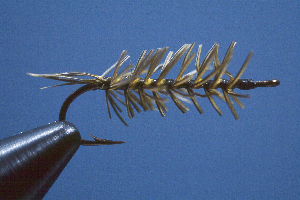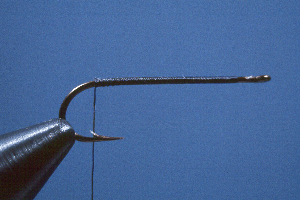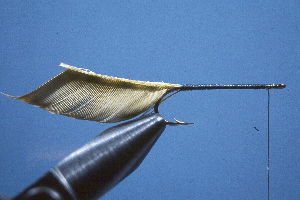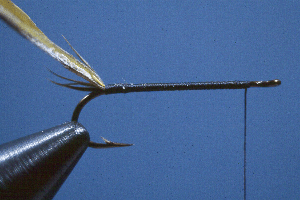 |
||
|
|
||
|
Bruce E.. Harang photo The Yallerhammer, a truly American Fly
The exact origin and birth
date of the Yallerhammer pattern has apparently been lost in the mists of
pre-recorded North American history. Unfortunately, American Indians did not
have written languages and passed their histories and customs down as oral
histories. It is generally accepted that it was the Cherokees who first brought
down a Yellow-shafted Flicker with a blowgun, wrapped its bright quill around a
hook, and caught a trout. Maybe they first tied the fly as they tied the deer
hair fly, reverse Palmer style. However, the Cherokee as an invader of the
Southeastern United States may have simply adapted what those they drove out
already were doing. Nevertheless, whatever the particulars it is clear that the
Yallerhammer fly pattern pre-dated European settlement of the Americas. "The two specimen flies which I enclose you will see are reversed hackles, made by cutting narrow strips of deerskin with the hair left on, wrapped around the hook a few times, and well tied at each end. The North Carolina Indians (Cherokee) tie them to perfection, using some sort of cement or waterproof varnish over the thread, and for the bodies the various colors and length of hair from different skins, but usually rather stiff hair, preferring it from the deer's legs. They often cut the hair off and use it without the skin, but made in this way the flies are not as durable. They use feathers occasionally in the same way…"
The original yallerhammer is
tied from the leading edge of the primary flight feather of the Yellow Shafted
Flicker (Yallerhammer), an endangered species of woodpecker. It is illegal to
possess this feather, so the primary flight feather of a dove or quail wing,
dyed golden yellow is used as a substitute when tying this pattern. To use this
feather for tying the fly you must first soak the wing feather in warm water, to
soften the quill. Then the softened quill is split length-wise and any pulp
within the center of the quill is cleaned out by scraping. Tie the prepared
quill in at the rear end of the hook shank so that the top few barbs extend
beyond the hook, forming a tail. Then wrap the split quill forward to the eye of
the hook, in touching turns, and tie off. The resulting "bottle Brush" is a
Yallerhammer. Recipe:
Hook: Mustad
9674 (size 6 — 12) Tying Instructions: 1. Attach the tying thread one hook eye length behind the eye and wrap a smooth thread base rearward to the end of the straight portion of the hook shank.
2. Tie in the split dove primary flight feather with the exposed interior side of the feather shaft facing up and the feather fibers down against the hook shank.
3. As you start to wrap the split flight feather the tail of the fly is automatically created from the feather fibers at the base end of the split feather shaft caught between the hook shank and the feather shaft.
4. Wrap the split dove primary flight feather forward, in touching turns, to the point where the thread is attached to the front of the hook shank.
5. Tie off the split dove primary flight feather and cut off the excess. 6. Wrap a small neat head, whip finish, and varnish if desired.
7. Trim the feather fibers to suitable length, slightly shorter than the hook gape distance.
This is an extremely easy fly to tie. Fishing it is equally simple. Cast down and across stream and strip the fly back in short (2 to 3 inch) movements. This is an especially good fly for streams having high and discolored water as the fly pushes lots of water and therefore makes quite a commotion allowing the fish to find the fly easily. Text, photos, and tying by Bruce E. Harang Click the BACK button on your browser to return to the fly pattern index page. |
||





